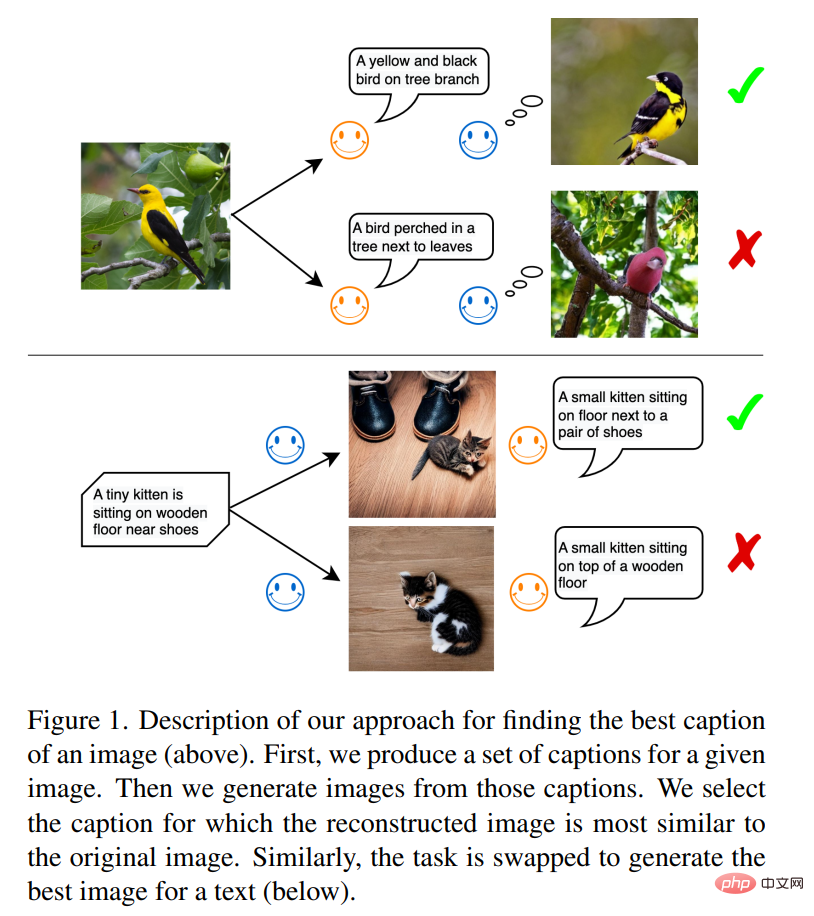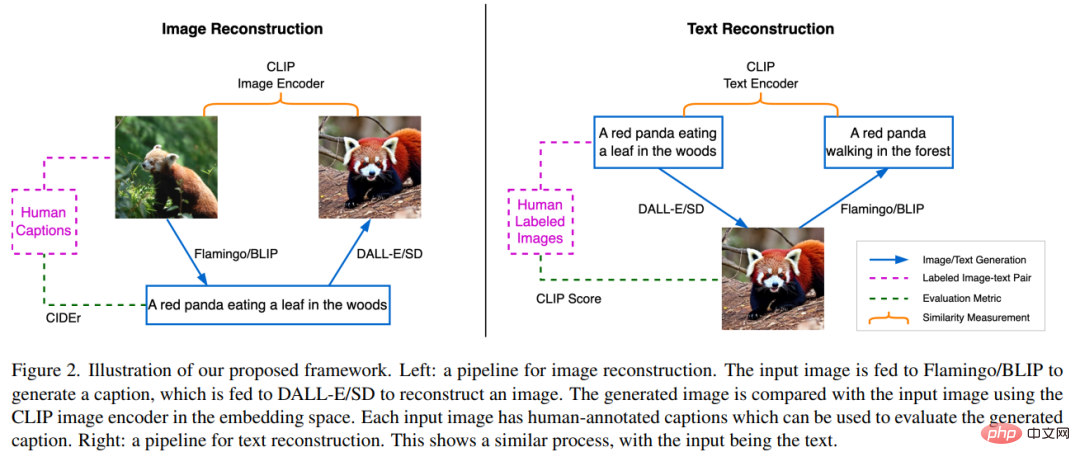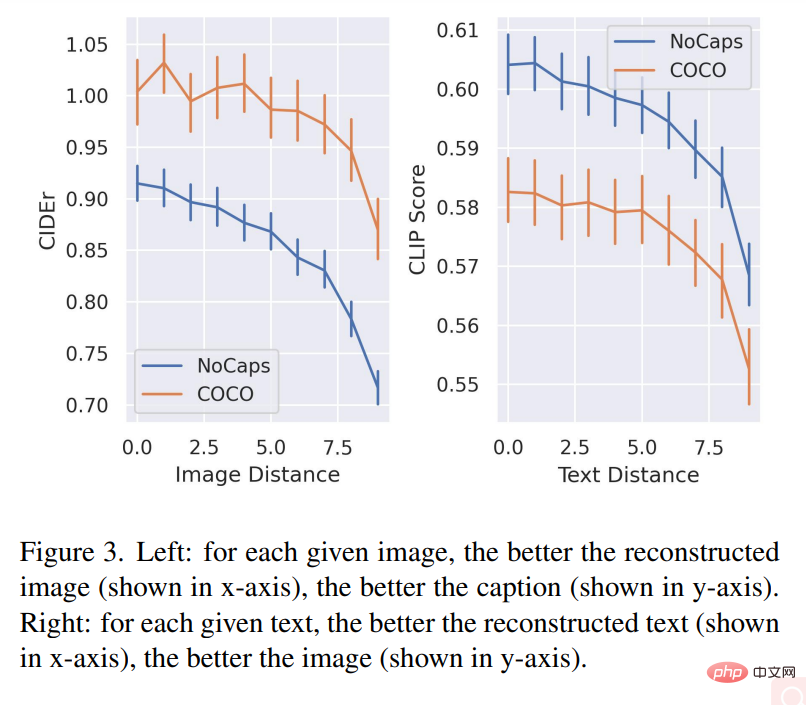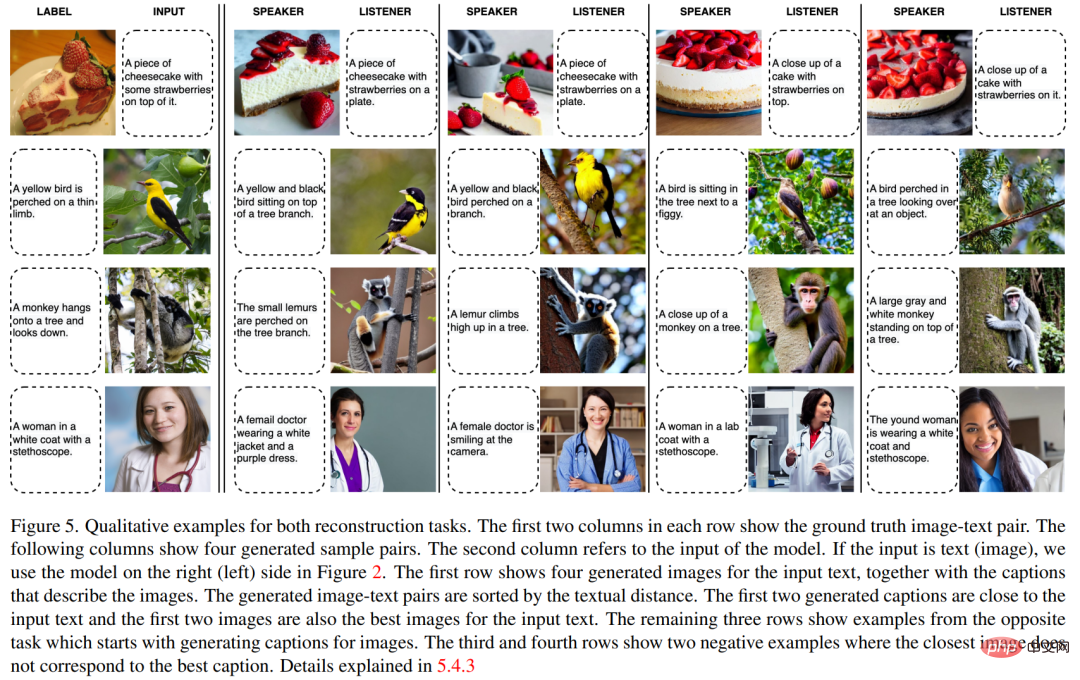 Technology peripherals
Technology peripherals
 AI
AI
 Can DALL-E and Flamingo understand each other? Three pre-trained SOTA neural networks unify images and text
Can DALL-E and Flamingo understand each other? Three pre-trained SOTA neural networks unify images and text
Can DALL-E and Flamingo understand each other? Three pre-trained SOTA neural networks unify images and text
An important goal of multi-modal research is to improve the machine's ability to understand images and text. In particular, researchers have made great efforts on how to achieve meaningful communication between the two models. For example, image captioning generation should be able to convert the semantic content of the image into coherent text that can be understood by humans. In contrast, text-image generative models can also exploit the semantics of textual descriptions to create realistic images.
This leads to some interesting questions related to semantics: For a given image, which textual description most accurately describes the image? Likewise, for a given text, what is the most meaningful way to implement an image? Regarding the first question, some studies claim that the best image description should be information that is both natural and can restore the visual content. As for the second question, meaningful images should be of high quality, diverse and faithful to the text content.
Either way, driven by human communication, interactive tasks involving text-image generative models and image-text generative models can help us select the most accurate image-text pairs.
As shown in Figure 1, in the first task, the image-text model is the information sender, and the text-image model is the information receiver. The sender's goal is to communicate the content of the image to the receiver using natural language so that it understands the language and reconstructs a realistic visual representation. Once the receiver can reconstruct the original image information with high fidelity, it indicates that the information has been successfully transferred. Researchers believe that the text description generated in this way is optimal, and the image generated through it is also most similar to the original image.

This rule is inspired by people’s use of language to communicate. Imagine the following scenario: In an emergency call scene, the police learn about the car accident and the status of the injured through the phone. This essentially involves the process of image description by witnesses at the scene. The police need to mentally reconstruct the environmental scene based on the verbal description in order to organize an appropriate rescue operation. Obviously, the best textual description should be the best guide to the reconstruction of the scene.
The second task involves text reconstruction: the text-image model becomes the message sender, and the image-text model becomes the message receiver. Once the two models agree on the content of the information at the textual level, the image medium used to convey the information is the optimal image that reproduces the source text.
In this article, the method proposed by researchers from the University of Munich, Siemens and other institutions is closely related to communication between agents. Language is the primary method for exchanging information between agents. But how can we be sure that the first agent and the second agent have the same understanding of what is a cat or what is a dog?

##Paper address: https://arxiv.org/pdf/2212.12249.pdf
The idea that this article wants to explore is to have the first agent analyze the image and generate text describing the image, and then the second agent obtains the text and simulates the image based on it. Among them, the latter process can be considered as a process of embodiment. The study believes that communication is successful if the image simulated by the second agent is similar to the input image received by the first agent (see Figure 1).
In the experiments, this study used off-the-shelf models, especially recently developed large-scale pre-trained models. For example, Flamingo and BLIP are image description models that can automatically generate text descriptions based on images. Likewise, image generation models trained on image-text pairs can understand the deep semantics of text and synthesize high-quality images, such as the DALL-E model and the latent diffusion model (SD).
Additionally, the study leveraged the CLIP model to compare images or text. CLIP is a visual language model that maps images and text in a shared embedding space. This study uses manually created image text datasets such as COCO and NoCaps to evaluate the quality of the generated text. Image and text generative models have stochastic components that allow sampling from a distribution, thus selecting the best from a range of candidate texts and images. Different sampling methods, including kernel sampling, can be used in image description models, and this article uses kernel sampling as the basic model to show the superiority of the method used in this article.
Method Overview
The framework of this article consists of three pre-trained SOTA neural networks. First, the image-text generation model; second, the text-image generation model; third, the multi-modal representation model consisting of an image encoder and a text encoder, which can map images or texts into their semantic embeddings respectively. .

Image reconstruction through text description
Figure 2 Left half As shown in the section, the image reconstruction task is to reconstruct a source image using language as instructions, and the implementation of this process will lead to the generation of optimal text describing the source scene. First, a source image x is fed to the BLIP model to generate multiple candidate texts y_k. For example, a red panda eats leaves in the woods. The generated set of text candidates is denoted by C, and then the text y_k is sent to the SD model to generate the image x’_k. Here x’_k refers to the image generated based on red panda. Subsequently, the CLIP image encoder is used to extract semantic features from the source and generated images:  and
and  .
.
Then the cosine similarity between these two embedding vectors is calculated with the purpose of finding the candidate text description y_s, i.e.

where s is the image index closest to the source image.
The study uses CIDEr (Image Description Metric) and references human annotations to evaluate the best texts. Since we were interested in the quality of the generated text, this study set the BLIP model to output text of approximately the same length. This ensures a relatively fair comparison, since the length of the text is positively correlated with the amount of information in the image that can be conveyed. During this work, all models are frozen and no fine-tuning is performed.
Text reconstruction through images
The right part of Figure 2 shows the reverse of the process described in the previous section. The BLIP model requires guessing the source text guided by an SD, which has access to the text but can only render its content in the form of an image. The process starts by using SD to generate candidate images x_k for the text y, and the resulting set of candidate images is denoted by K. Generating images using SD involves a random sampling process, where each generation process may end up with different valid image samples in a huge pixel space. This sampling diversity provides a pool of candidates to filter out the best images. The BLIP model then generates a text description y’_k for each sampled image x_k. Here y’_k refers to the initial text A red panda crawling in the forest. The study then used the CLIP text encoder to extract features of the source text and generated text, represented by  and
and  , respectively. The purpose of this task is to find the best candidate image x_s that matches the semantics of the text y. To do this, the study needs to compare the distance between the generated text and the input text, and then select the image with the smallest distance between the paired texts, i.e.
, respectively. The purpose of this task is to find the best candidate image x_s that matches the semantics of the text y. To do this, the study needs to compare the distance between the generated text and the input text, and then select the image with the smallest distance between the paired texts, i.e.

The study believes that the image x_s can best depict the text description y because it can deliver the content to the receiver with minimal information loss. Furthermore, this study treats the image  corresponding to the text y as a reference presentation of y, and quantifies the best image as its proximity to the reference image.
corresponding to the text y as a reference presentation of y, and quantifies the best image as its proximity to the reference image.
Experimental Results
The left chart in Figure 3 shows the correlation between image reconstruction quality and description text quality on the two datasets. For each given image, the better the reconstructed image quality (shown in the x-axis), the better the text description quality (shown in the y-axis).
The right graph of Figure 3 reveals the relationship between the quality of the recovered text and the quality of the generated image: for each given text, the reconstructed text description (shown at x The better the y-axis), the better the image quality (shown on the y-axis).

Figure 4 (a) and (b) shows the relationship between the image reconstruction quality and the average text quality based on the source image. relationship between. Figure 4(c) and (d) show the correlation between text distance and reconstructed image quality.

Table 1 shows that the study’s sampling method outperforms kernel sampling in every metric, and the model’s The relative gain can be as high as 7.7%.

Figure 5 shows qualitative examples of two reconstruction tasks.

The above is the detailed content of Can DALL-E and Flamingo understand each other? Three pre-trained SOTA neural networks unify images and text. For more information, please follow other related articles on the PHP Chinese website!

Hot AI Tools

Undresser.AI Undress
AI-powered app for creating realistic nude photos

AI Clothes Remover
Online AI tool for removing clothes from photos.

Undress AI Tool
Undress images for free

Clothoff.io
AI clothes remover

AI Hentai Generator
Generate AI Hentai for free.

Hot Article

Hot Tools

Notepad++7.3.1
Easy-to-use and free code editor

SublimeText3 Chinese version
Chinese version, very easy to use

Zend Studio 13.0.1
Powerful PHP integrated development environment

Dreamweaver CS6
Visual web development tools

SublimeText3 Mac version
God-level code editing software (SublimeText3)

Hot Topics
 1377
1377
 52
52
 The world's most powerful open source MoE model is here, with Chinese capabilities comparable to GPT-4, and the price is only nearly one percent of GPT-4-Turbo
May 07, 2024 pm 04:13 PM
The world's most powerful open source MoE model is here, with Chinese capabilities comparable to GPT-4, and the price is only nearly one percent of GPT-4-Turbo
May 07, 2024 pm 04:13 PM
Imagine an artificial intelligence model that not only has the ability to surpass traditional computing, but also achieves more efficient performance at a lower cost. This is not science fiction, DeepSeek-V2[1], the world’s most powerful open source MoE model is here. DeepSeek-V2 is a powerful mixture of experts (MoE) language model with the characteristics of economical training and efficient inference. It consists of 236B parameters, 21B of which are used to activate each marker. Compared with DeepSeek67B, DeepSeek-V2 has stronger performance, while saving 42.5% of training costs, reducing KV cache by 93.3%, and increasing the maximum generation throughput to 5.76 times. DeepSeek is a company exploring general artificial intelligence
 AI subverts mathematical research! Fields Medal winner and Chinese-American mathematician led 11 top-ranked papers | Liked by Terence Tao
Apr 09, 2024 am 11:52 AM
AI subverts mathematical research! Fields Medal winner and Chinese-American mathematician led 11 top-ranked papers | Liked by Terence Tao
Apr 09, 2024 am 11:52 AM
AI is indeed changing mathematics. Recently, Tao Zhexuan, who has been paying close attention to this issue, forwarded the latest issue of "Bulletin of the American Mathematical Society" (Bulletin of the American Mathematical Society). Focusing on the topic "Will machines change mathematics?", many mathematicians expressed their opinions. The whole process was full of sparks, hardcore and exciting. The author has a strong lineup, including Fields Medal winner Akshay Venkatesh, Chinese mathematician Zheng Lejun, NYU computer scientist Ernest Davis and many other well-known scholars in the industry. The world of AI has changed dramatically. You know, many of these articles were submitted a year ago.
 Hello, electric Atlas! Boston Dynamics robot comes back to life, 180-degree weird moves scare Musk
Apr 18, 2024 pm 07:58 PM
Hello, electric Atlas! Boston Dynamics robot comes back to life, 180-degree weird moves scare Musk
Apr 18, 2024 pm 07:58 PM
Boston Dynamics Atlas officially enters the era of electric robots! Yesterday, the hydraulic Atlas just "tearfully" withdrew from the stage of history. Today, Boston Dynamics announced that the electric Atlas is on the job. It seems that in the field of commercial humanoid robots, Boston Dynamics is determined to compete with Tesla. After the new video was released, it had already been viewed by more than one million people in just ten hours. The old people leave and new roles appear. This is a historical necessity. There is no doubt that this year is the explosive year of humanoid robots. Netizens commented: The advancement of robots has made this year's opening ceremony look like a human, and the degree of freedom is far greater than that of humans. But is this really not a horror movie? At the beginning of the video, Atlas is lying calmly on the ground, seemingly on his back. What follows is jaw-dropping
 KAN, which replaces MLP, has been extended to convolution by open source projects
Jun 01, 2024 pm 10:03 PM
KAN, which replaces MLP, has been extended to convolution by open source projects
Jun 01, 2024 pm 10:03 PM
Earlier this month, researchers from MIT and other institutions proposed a very promising alternative to MLP - KAN. KAN outperforms MLP in terms of accuracy and interpretability. And it can outperform MLP running with a larger number of parameters with a very small number of parameters. For example, the authors stated that they used KAN to reproduce DeepMind's results with a smaller network and a higher degree of automation. Specifically, DeepMind's MLP has about 300,000 parameters, while KAN only has about 200 parameters. KAN has a strong mathematical foundation like MLP. MLP is based on the universal approximation theorem, while KAN is based on the Kolmogorov-Arnold representation theorem. As shown in the figure below, KAN has
 Google is ecstatic: JAX performance surpasses Pytorch and TensorFlow! It may become the fastest choice for GPU inference training
Apr 01, 2024 pm 07:46 PM
Google is ecstatic: JAX performance surpasses Pytorch and TensorFlow! It may become the fastest choice for GPU inference training
Apr 01, 2024 pm 07:46 PM
The performance of JAX, promoted by Google, has surpassed that of Pytorch and TensorFlow in recent benchmark tests, ranking first in 7 indicators. And the test was not done on the TPU with the best JAX performance. Although among developers, Pytorch is still more popular than Tensorflow. But in the future, perhaps more large models will be trained and run based on the JAX platform. Models Recently, the Keras team benchmarked three backends (TensorFlow, JAX, PyTorch) with the native PyTorch implementation and Keras2 with TensorFlow. First, they select a set of mainstream
 Tesla robots work in factories, Musk: The degree of freedom of hands will reach 22 this year!
May 06, 2024 pm 04:13 PM
Tesla robots work in factories, Musk: The degree of freedom of hands will reach 22 this year!
May 06, 2024 pm 04:13 PM
The latest video of Tesla's robot Optimus is released, and it can already work in the factory. At normal speed, it sorts batteries (Tesla's 4680 batteries) like this: The official also released what it looks like at 20x speed - on a small "workstation", picking and picking and picking: This time it is released One of the highlights of the video is that Optimus completes this work in the factory, completely autonomously, without human intervention throughout the process. And from the perspective of Optimus, it can also pick up and place the crooked battery, focusing on automatic error correction: Regarding Optimus's hand, NVIDIA scientist Jim Fan gave a high evaluation: Optimus's hand is the world's five-fingered robot. One of the most dexterous. Its hands are not only tactile
 FisheyeDetNet: the first target detection algorithm based on fisheye camera
Apr 26, 2024 am 11:37 AM
FisheyeDetNet: the first target detection algorithm based on fisheye camera
Apr 26, 2024 am 11:37 AM
Target detection is a relatively mature problem in autonomous driving systems, among which pedestrian detection is one of the earliest algorithms to be deployed. Very comprehensive research has been carried out in most papers. However, distance perception using fisheye cameras for surround view is relatively less studied. Due to large radial distortion, standard bounding box representation is difficult to implement in fisheye cameras. To alleviate the above description, we explore extended bounding box, ellipse, and general polygon designs into polar/angular representations and define an instance segmentation mIOU metric to analyze these representations. The proposed model fisheyeDetNet with polygonal shape outperforms other models and simultaneously achieves 49.5% mAP on the Valeo fisheye camera dataset for autonomous driving
 DualBEV: significantly surpassing BEVFormer and BEVDet4D, open the book!
Mar 21, 2024 pm 05:21 PM
DualBEV: significantly surpassing BEVFormer and BEVDet4D, open the book!
Mar 21, 2024 pm 05:21 PM
This paper explores the problem of accurately detecting objects from different viewing angles (such as perspective and bird's-eye view) in autonomous driving, especially how to effectively transform features from perspective (PV) to bird's-eye view (BEV) space. Transformation is implemented via the Visual Transformation (VT) module. Existing methods are broadly divided into two strategies: 2D to 3D and 3D to 2D conversion. 2D-to-3D methods improve dense 2D features by predicting depth probabilities, but the inherent uncertainty of depth predictions, especially in distant regions, may introduce inaccuracies. While 3D to 2D methods usually use 3D queries to sample 2D features and learn the attention weights of the correspondence between 3D and 2D features through a Transformer, which increases the computational and deployment time.



